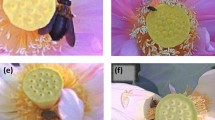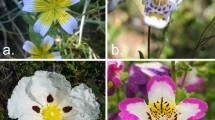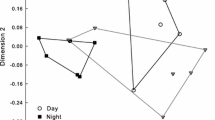Abstract
Most estimations of the pollination efficiency of insects have been based on observation by the naked human eye. However, insect behaviors are often too rapid to analyze sufficiently this way. Here we demonstrate the use of high-speed cameras to analyze the fine-scale behaviors of Macroglossum pyrrhosticta, Xylocopa appendiculata, and Papilio dehaanii when visiting Clerodendrum trichotomum. The fine-scale nectar drinking time, number of contacts with anthers and/or stigmas, and frequencies of body part contact with anthers and/or stigmas differed significantly among pollinator species. Pollination efficiency was not equal among pollinators. In addition, M. pyrrhosticta made the least number of contacts with anthers and/or stigmas even though it showed the highest visitation frequency. These results demonstrate that when examined from the viewpoint of rapid visitation behaviors, pollination dynamics differ among pollinator species, and flower visits and pollination rates are not equal.




Similar content being viewed by others
References
Altshuler DL, Dickson WB, Vance JT, Roberts SP, Dickinson MH (2005) Short-amplitude high-frequency wing strokes determine the aerodynamics of honeybee flight. Proc Natl Acad Sci USA 102:18213–18218
Bell G (1985) On the function of flowers. P Roy Soc Lond B Bio 224:223–265
Broyles BS, Wyatt R (1991) Effective pollen dispersal in a natural population of Asclepias exaltata: the influence of pollinator behavior, genetic similarity, and mating success. Am Nat 138:1239–1249
Campbell DR, Waser NM, Pederson GT (2002) Predicting patterns of mating and potential hybridization from pollinator behavior. Am Nat 159:428–450
Chittka L, Gumbert A, Kunze J (1997) Foraging dynamics of bumble bees: correlates of movements within and between plant species. Behav Ecol 8:239–249
Cunningham SA (2000) Depressed pollination in habitat fragments causes low fruit set. P Roy Soc Lond B Bio 267:1149–1152
Herrera CM (1989) Pollinator abundance, morphology, and flower visitation rate: analysis of the “quantity” component in a plant–pollinator system. Oecologia 80:241–248
Inoue H (1982) Sphingoidea. In: Inoue H, Sugi S, Kuroko H, Morriuti S, Kawabe A, Owada M (eds) Moths of Japan 1. Kodansha Ltd., Tokyo, pp 590–603 (in Japanese)
Inouye DW (1980) The terminology of floral larceny. Ecology 61:1251–1253
Ishii HS, Harder LD (2006) The size of individual Delphinium flowers and the opportunity for geitonogamous pollination. Funct Ecol 20:1115–1123
Kephart S, Theiss K (2003) Pollinator-mediated isolation in sympatric milkweeds (Zasclepias): do floral morphology and insect behavior influence species boundaries? New Phytol 161:265–277
Kudo G, Ishii HS, Hirabayashi Y, Ida TY (2007) A test of the effect of floral color change on pollination effectiveness using artificial inflorescences visited by bumblebees. Oecologia 154:119–128
Makino TT, Ohashi K, Sakai S (2007) How do floral display size and the density of surrounding flowers influence the likelihood of bumble bee revisitation to a plant? Funct Ecol 21:87–95
Miyake T, Inoue K (2003) Character displacement in style length between pollinator-sharing Clerodendrum trichotomum and C. izuinsulare (Verbenaceae). Plant Syst Evol 243:31–38
Muchhala N, Potts MD (2007) Character displacement among bat-pollinated flowers of the genus Burmeistera: analysis of mechanism, process and pattern. P Roy Soc Lond B Bio 274:2731–2737
Murata G (1989) Vervenaceae. In: Satake Y, Hara H, Watari S, Tominari T (eds) Wild flowers of Japan woody plants. Heibonsha, Tokyo, pp 209–215 (in Japanese)
Ohashi K (2002) Consequences of floral complexity for bumblebee-mediated geitonogamous self-pollination in Salvia nipponica Miq. (Labiatae). Evolution 56:2414–2423
Okutani T (1977) Anthophoridae. In: Ito S, Okutani T, Hiura I (ed) Colored illustrations of the insects of Japan vol. II Protura, Diplura, Thysanura, Collembola, Ephemeroptera, Odonata, Plecoptera, Grylloblattodea, Dictyoptera, Dermaptera, Phasmida, Orthoptera, Isoptera, Embioptera, Psocoptera, Mallophaga, Anoplura, Thysanoptera, Hemiptera, Mecoptera, Neuroptera, Trichoptera, Diptera, Siphonaptera, Strepsiptera and Hymenoptera. Hoikusha, Tokyo, pp 336–337 (in Japanese)
Olesen JM, Warncke E (1989) Temporal changes in pollen flow and neghbourhood structure in a population of Saxifraga hirculus L. Oecologia 79:205–211
Osborne JL, Clark SJ, Morris RJ, Williams IH, Riley JR, Smith AD, Reynolds DR, Edwards AS (1999) A landscape-scale study of bumble bee foraging range and constancy using harmonic radar. J Appl Ecol 36:519–533
Schulke B, Waser NM (2001) Long-distance pollinator flights and pollen dispersal between populations of Delphinium nuttallianum. Oecologia 127:239–245
Shirouzu T (2006) Papilionidae. In: Yata O, Yago M (eds) The butterflies of Japan in color. Gakken Shuppan Service, Tokyo, pp 12–45 (in Japanese)
Sutherland S, Delph LF (1984) On the importance of male fitness in plants: patterns of fruit-set. Ecology 65:1093–1104
Unwin DM, Corbet SA (1984) Wingbeat frequency, temperature and body size in bees and flies. Physiol Entomol 9:115–121
Ushimaru A, Watanabe T, Nakata K (2007) Colored floral organs influence pollinator behavior and pollen transfer in Commelina communis (Commelinaceae). Am J Bot 94:249–258
Utelli AB, Roy BA (2000) Pollinator abundance and behavior on Aconitum lycoctonum (Ranunculaceae): an analysis of the quantity and quality components of pollination. Oikos 89:461–470
van der Pijl L (1961) Ecological aspects of flower evolution. II. Zoophilious flower classes. Evolution 15:44–59
Vazquez DP, Aizen MA (2003) Null model analyses of specialization in plant–pollinator interactions. Ecology 84:2493–2501
Vazquez DP, Morris WF (2005) Interaction frequency as a surrogate for the total effect of animal mutualists on plants. Ecol Lett 8:1088–1094
Wada N, Uemura S (2000) Size-dependent flowering behavior and heat production of a sequential hermaphrodite, Sympocarpus renifolius (Araceae). Am J Bot 87:1489–1494
Warren J, James P (2008) Do flowers wave to attract pollinators? A case study with Silene maritime. J Evol Biol 21:1024–1029
Wyatt R (1983) Pollinator plant interactions and the evolution of breeding systems. In: Real L (ed) Pollination biology. Academic, New York, pp 51–96
Acknowledgments
We thank Kôji Sasakawa for useful comments on the manuscript and statistics. We also thank Joel H. Nitta for revising the English manuscript. This study was supported in part by funding from the Fujiwara Natural History Foundation to RLS, the Environment Research and Technology Development Fund (S-9) of the Ministry of the Environment, Japan to SIM, and the Environment Research and Technology Development Fund (D-1008) of the MOE and the National BioResource Project of MEXT to MI.
Ethical standards
Our experiments comply with the current laws in Japan.
Conflict of interest
The authors declare that they have no conflict of interest.
Author information
Authors and Affiliations
Corresponding author
Additional information
Communicated by M. Giurfa
Appendix
Supplementary movie S1 Movie of a visit of M. pyrrhosticta to the pistillate flower of C. trichotomum. This movie was recorded over 1 s. In this movie, M. pyrrhosticta did not contact the stigma
ESM 1
(M2V 10.4mb)
Rights and permissions
About this article
Cite this article
Sakamoto, R.L., Morinaga, SI., Ito, M. et al. Fine-scale flower-visiting behavior revealed by using a high-speed camera. Behav Ecol Sociobiol 66, 669–674 (2012). https://doi.org/10.1007/s00265-011-1314-z
Received:
Revised:
Accepted:
Published:
Issue Date:
DOI: https://doi.org/10.1007/s00265-011-1314-z




